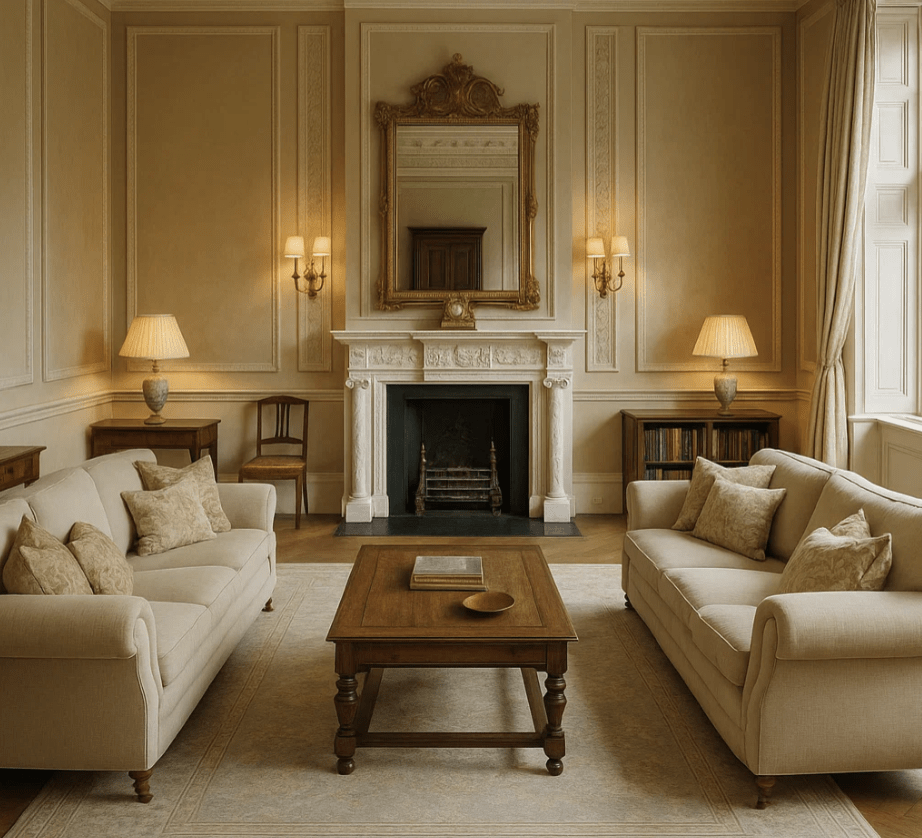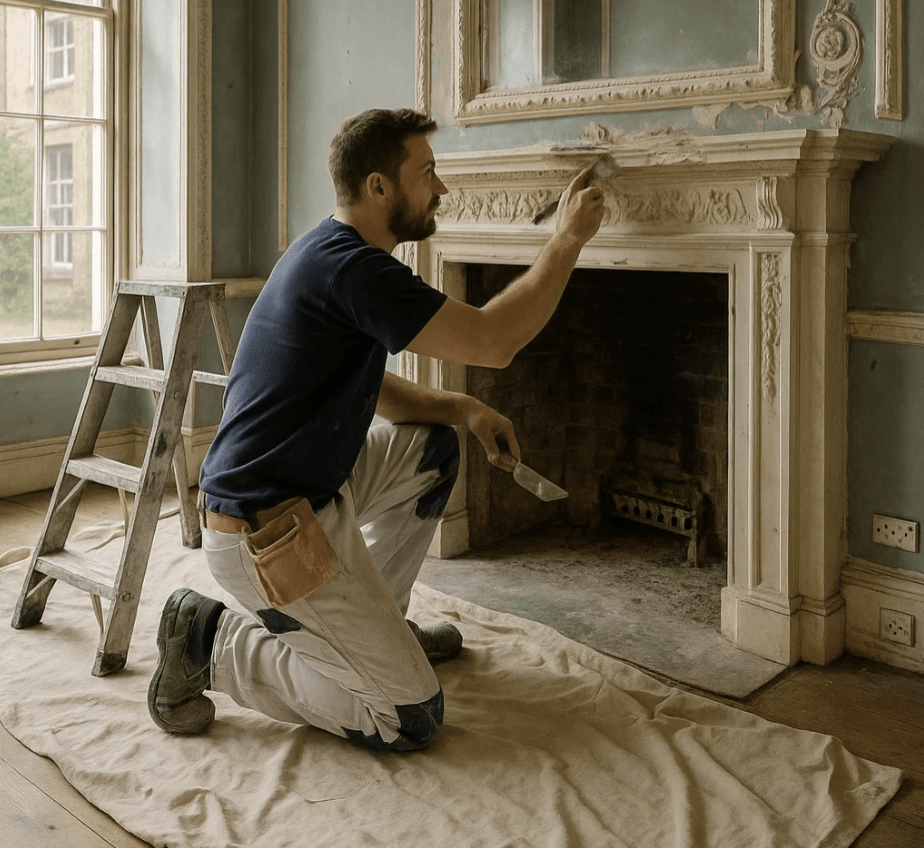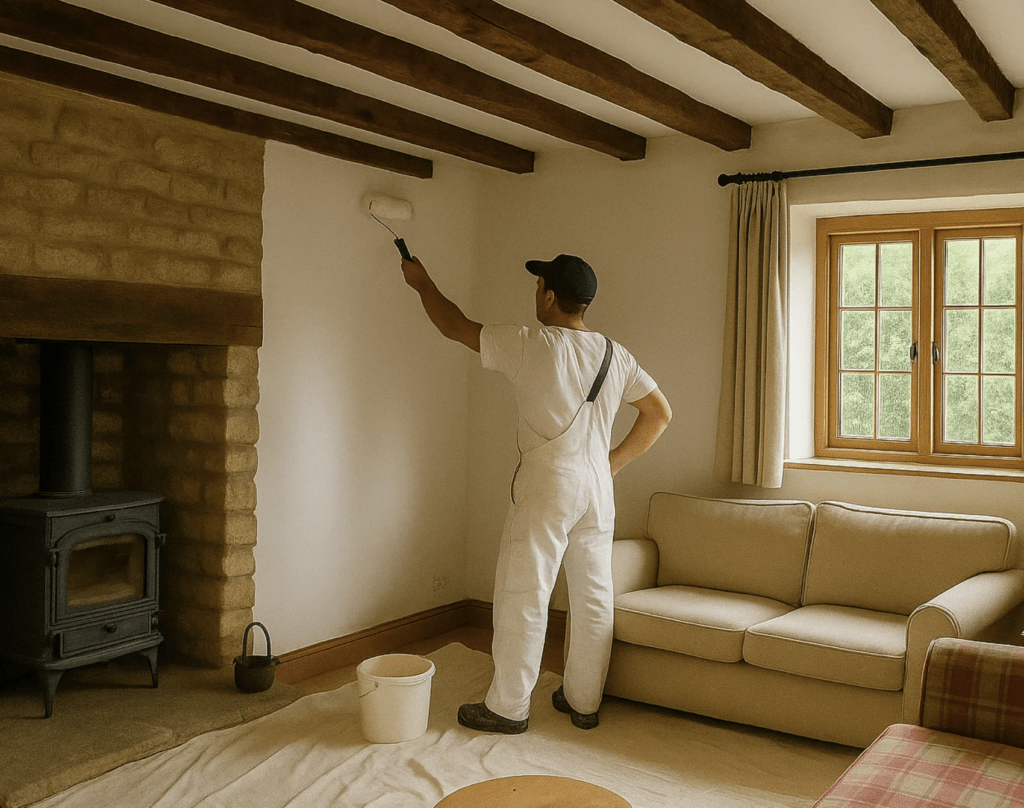Designing a lounge in a listed property is a rewarding challenge that combines respect for the history of the property with modern living. Listed homes, whether medieval cottages or Edwardian townhouses, come with character features and legal protections that homeowners must be aware of. The goal is to create a comfortable, personalised lounge that respects the building’s heritage while meeting your lifestyle needs. It’s not always an easy balance!
This guide covers essential considerations, from understanding regulations and preserving original features to selecting the right décor and discreetly incorporating modern comforts, so that you can design your living room with confidence.
Listed Building Consent
Owning a listed building means any significant changes to your home are subject to certain rules. In the UK, Listed Building Consent is required for any alteration that affects the character or appearance of a listed building, whether internal or external. In other words, the interior of your home is just as protected as its exterior. A common misconception is that Grade II listings only control the outside, but in fact, listed building control is equally applied to all grades. This doesn’t mean your house can’t change; it simply ensures that changes won’t harm what makes the building special.
Carrying out unauthorised works to a listed building is a criminal offence, and individuals can be prosecuted.

Local Planning Authority
Before undertaking any significant interior design projects, consult your Local Planning Authority (LPA), including the Conservation Officer, regarding your plans. Even seemingly minor works can require consent if they alter historic fabric or character, so it’s wise to always contact the relevant Planning Authority before planning work. On the other hand, like-for-like repairs and purely cosmetic updates typically don’t require formal approval.
Routine maintenance, furnishings, carpeting, and most internal decoration are typically exempt from consent so long as they don’t disturb original features. For example, you wouldn’t need permission to repaint your walls or update furniture, but knocking down an old plaster wall or removing an antique mantel would definitely require consent. Failing to get consent for unauthorised alterations is a serious risk; homeowners have been prosecuted or ordered to undo work done without approval. The consent application process typically takes around 6–8 weeks, so please factor this into your project timeline. Overall, a solid understanding of listed building regulations and a willingness to follow them is the basis for any design decisions in your lounge.
Preserving Historical Features:
One of the joys of listed homes is the wealth of period features they contain. Your lounge may boast ornate plaster cornices, a ceiling rose, a grand fireplace, exposed timber beams, panelled walls, or original floorboards. Preserving historical features is therefore vital. They are integral to the building’s character and often the very reason the property is listed.
Plan your design to celebrate and work around these elements, rather than removing or concealing them. For example, if your lounge has a beautiful original fireplace or timber mantle, consider making it the focal point of the room. Arrange seating around it and consider restoration to make it a functional fire. While open fires are inefficient and their use in Smoke Controlled Areas is prohibited, you could consider the viability of having an ecodesign wood-burning stove fitted in it’s place, depending on what is acceptable with the Local Planning Authority. You are not limited to burning wood either. There is a huge choice of gas and electric fires which could also work – again, LPA permitting.
Similarly, expose and treat old beams instead of boxing them in, and retain decorative mouldings on ceilings and walls. These details lend an authenticity no modern replica can match.
Repair Where Possible:
When repairs are needed, the golden rule is to repair, not replace, wherever possible. Older features were crafted from high-quality materials intended to last, and with skilled restoration, they can usually do so.
For instance, if you find that your window frames are rotten in places, instead of replacing the entire window, you should ask a joiner to repair the rotten area. By doing so, you preserve the rest of the frame. The same principle applies to fixtures like beams or cornices, patch and mend rather than rip out. There are specialist craftspeople available, such as heritage joiners, plaster restorers, and stone masons, who can restore period details to their former glory. Only if an element is truly beyond repair should you consider replacement; even then, it should be like-for-like, using matching designs and materials. In some cases, an obviously modern intervention might be allowed, but always check with your conservation officer to determine what is appropriate.

Reinstating Historic Features:
Identify which original architectural elements have disappeared over the years and look for opportunities to reinstate them; doing so instantly elevates a room’s character. Revealing an original hearth or fitting a period‑appropriate surround to a bricked‑up fireplace, for example, can reawaken the space’s historic feel. Heritage design specialists note that restoring features such as traditional plasterwork, fireplaces, or antique tilework can really shape an interior scheme in a period property.
Architectural salvage yards and specialist suppliers offer authentic, reclaimed materials, enabling you to incorporate modern additions with elements that genuinely belong in the property. By preserving and reviving these historic details, you not only protect the building’s value but also create an atmosphere that new construction can never replicate.
Working with the Local Conservation Officer:
Embarking on any changes in a listed home’s interior means working hand-in-hand with your local conservation officer and obtaining Listed Building Consent for the alterations. It’s best to view the conservation officer as an ally in your project; their role is to help you find solutions that upgrade your living space while safeguarding the home’s heritage.
Early in the planning, discuss your ideas with them or the planning department. They can advise on which parts of the building are most sensitive, what type of alterations are likely to be approved, and any necessary documentation that may be required. Remember, local Conservation and Planning Officers have the authority to reject or request changes to any proposals, so it pays to collaborate and understand their perspective. Often, they can suggest alternative approaches that achieve your goals in a more historically sympathetic way.
Selecting the best colours, materials and furnishings:
When decorating a lounge in a listed property, you should let the home’s architecture guide your design choices. A rule of thumb from heritage designers is to be sympathetic to the existing architectural details of the property and work with the building, rather than feeling that it is working against your design plans. Start by observing the colours, textures, and materials already present in the room: perhaps aged oak beams, stone hearth, or decorative plaster. Look for a palette and materials that complement these elements. Many listed homeowners opt for heritage paint colours or soft neutrals that accentuate details without overpowering them. For example, muted greens, off-whites, warm terracottas, or gentle blues can beautifully highlight parts of a period lounge.
For materials and finishes, choose high-quality, natural options and traditional techniques whenever possible. Wood, stone, plaster, and natural fibres tend to age well and fit in historic settings. If you’re refinishing woodwork, consider using stains or paints that reveal the grain rather than thick acrylics. Avoid wall-to-wall synthetic carpeting if possible; instead, consider refinishing the original wood floor and using area rugs for added comfort. Be mindful of your listed building’s construction; old houses need to “breathe.” Modern impermeable materials can inadvertently cause damage. For instance, covering original lime-plastered walls with drywall or vinyl paint can trap moisture, leading to possible decay.
Choosing furnishings for a historic lounge is an opportunity to truly express your own personal style, but it’s essential to ensure that your selections remain sympathetic to the period character of the space. For example, in a grand Georgian drawing room with beautiful high ceilings and classic furniture, rich fabrics will generally feel more fitting than an ultra-minimalist look. In a cosy 17th-century cottage lounge, you might focus more on rustic charm with comfortable sofas, tweeds, floral prints, and antiques.
That said, there is always room to introduce modern touches to reflect your own taste, even in the most traditional settings. The key lies in striking the right balance. You might pair a sleek contemporary coffee table with a vintage Chesterfield sofa or hang modern artwork above an original mantelpiece. These contrasts often enhance the beauty of both old and new elements.
Creating a mood board, perhaps on Pinterest, using interiors from homes of a similar era, can help you visualise how to blend historic features with more modern pieces in a cohesive way. Aim for a design that feels harmonious and rooted in the room’s history while expressing your personal style, and you’ll achieve a design that feels authentic and timeless.

Modern comforts – done discreetly:
One challenge in listed homes is incorporating modern amenities without visibly or physically compromising their character. In your lounge, you’ll likely want efficient heating, ample lighting, entertainment systems, and other 21st-century comforts. All of which can be added with careful planning. The secret is to incorporate technology invisibly or in a reversible way, so the historic fabric remains intact and the room’s character is still there.
Heating and insulation:
If your lounge is drafty, look for solutions that don’t involve removing original features. For instance, traditional single-pane windows are often protected, meaning you are unlikely to get permission to replace them with double glazing. Instead, look at secondary glazing panels fitted to the interior of the window. These can offer similar insulation benefits without altering the external appearance or removing historic glass. Heavy, lined curtains or thermal blinds, designed in period-appropriate fabrics, are another non-invasive way to keep warm on cold nights. If the room has an old fireplace, check if it can be used or fitted with a modern ecodesign wood-burning or gas/electric stove insert. This can provide heat and still be in keeping with the home’s character.
For central heating, modern radiators come in traditional cast-iron styles that won’t look out of place beneath a sash window. You might also consider underfloor heating if you’re updating your flooring, as it’s invisible; just make sure the installation doesn’t damage any original floor structure and is permitted. Always use qualified professionals for plumbing or heating work on a listed building, as they’ll know how to route pipes without harming historic elements, which are often located within floor voids or behind skirting boards. Remember, older buildings are designed to breathe; overly sealing up the room can cause damp, so balance insulation with ventilation.
Lighting and electrical:
A good lighting set-up makes a lounge welcoming, but in a listed home, it requires some thought. Drilling numerous holes for modern recessed downlights or running new cables through old plaster can destroy its historic feel, and would likely be frowned on by conservation officers. Instead, opt for surface or hidden solutions that minimise invasive changes. You could install a few strategic ceiling hooks or use existing beams to hang pendant lights or chandeliers, utilising existing wiring routes if possible. Wall lights might be mounted on plaster without chiselling in cables by using surface-mounted conduit painted to blend in, or by wiring through adjoining rooms or floors. Often, the easiest way is to rely on lamps for layered lighting; floor and table lamps can give a warm glow and only require plugging into sockets.
If you don’t have enough sockets, you might get permission to add a couple in unobtrusive spots. Rather than chiselling into walls, see if an electrician can lift a floorboard and run wiring underneath, popping up to a new socket. Many smart home technologies are designed to minimise wiring requirements. Modern wireless LED bulbs, remote-controlled switches, and systems like Alexa/Google that connect devices mean you can have advanced lighting schemes and sound systems with minimal hardwiring. Smart bulbs in your lamps can be programmed for different moods without the need for dimmer switches, and wireless speakers can provide music without running speaker cables through walls.
Audio-visual and other tech:
Incorporating a TV or sound system in a period lounge is possible without compromising the room’s aesthetic with a tangle of wires. Many owners hide TVs behind cabinet doors or within a period-looking cabinet, so when not in use, the technology is out of sight. Another trick is using mirror TVs (a screen that looks like a mirror when off) above a fireplace, which can fit in grand rooms. Choose electronics in finishes that blend with your décor, such as a retro-style radio or a brass-finished floor lamp that doubles as a smart speaker.
Route cables along baseboards or in corners where they can be camouflaged, or use flat wire tape that can be painted over to blend in. It’s also worth planning where you’ll need internet or phone connections; sometimes these can be tucked behind furniture or run externally, then brought in through an existing opening to avoid drilling new holes in historic walls. Security systems can be wireless these days, with small sensors that won’t mar your period door frames. Essentially, for any modern convenience, ask: Can I install or use this in a way that’s reversible and doesn’t permanently alter the room? If yes, you’re likely on the right track. By integrating modern comforts subtly, you’ll enjoy all the functionality of a new home while maintaining the visual integrity of your old one.
To Conclude:
Designing a lounge in a listed property may require extra care, but the results are unquestionably worth it. By understanding the regulations, working collaboratively with conservation authorities, preserving and highlighting the features that make your home unique, and decorating with sensitivity, you can create a living space that seamlessly blends historic charm with modern comfort.
The process encourages you to get to know your home’s story and become a part of it going forward. In the end, you’ll have not only a stylish, cosy lounge tailored to your taste, but also the satisfaction of knowing you’ve considered the heritage of your property for years to come.








